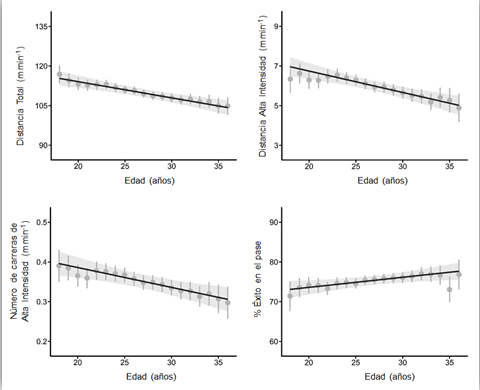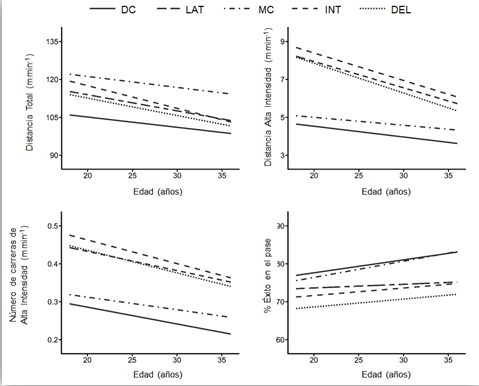September 29, 2021
Psychology
Sports Performance
How does the physical and technical-tactical performance of football players evolve throughout their sports career?
Top-level athletes are getting older and older. Technology, materials, nutrition, preparation, injury prevention, financial investment, scientific knowledge, and the excellent level of coaches are some of the factors that have lengthened players’ careers. In tennis, for example, the average age of the top-100 tennis players in the ATP (Association of Tennis Professionals) ranking has gone from 1985 to 2017, from 25 to 29 years. If in 2003, there were only ten players over 30 years old in the top 100; in 2017, there were 41. In swimming, the average age of Olympic medalists from 1964 to 2012 increased from 17.6 to 22 years for women and from 20.8 to 24.5 for men.1 Football is no stranger to this phenomenon of aging athletes. The average age of players who participated in the Champions League between seasons 1992-1993 and 2017-2018 has increased by 1.6 years, from 24.9 to 26.5.2
Professional football players usually finish their sports career between the ages of 31 and 35, with an average duration of 8 to 11 years in the elite.3 Some studies have shown that the maximum performance age is between 25 and 27, depending on the game position. Forwards appear to reach their peak earlier (around the age of 25) than midfielders and defenders (at about age 27).2,4-8 However, much less is known about the evolution of players’ performance from that peak to their sporting retirement.
A recent study has analyzed the age effect on the physical and technical-tactical performance of the players in LaLiga Santander. 9 For this purpose, the in-competition performance of 154 players who participated in the competition between the 2012/2013 and 2019/2020 seasons was analyzed. The inclusion criterion is to have played at least 5 full matches each year for at least 5 seasons in the period analyzed. The novelty of this work is that it is a longitudinal study. The same player has been studied throughout his sports career in LaLiga since he was very young until he retired from sports. 14,902 observations have been collected with an average of 15.2 ± 7.0 games per player and season. The analysis included the performance of 37 centre-backs (3769 observations), 44 full-backs (4233 observations), 34 midfielders (3281 observations), 22 inside forwards (1535 observations), and 17 forwards (1274 observations).
The first figure shows how the total distance covered by football players is reduced by 0.56% per year from the highest value, which is reached when they are younger. The distance covered at a high intensity (> 21.0 km / h) and the number of high-intensity sprints also decreased by 1.80% and 1.42% each year, respectively. However, the percentage of successful passes increases by 0.25% per year.

In the second figure, we see the same information, but considering the specific position of the football players. Regarding the total distance, the effect of age is greater for full-backs, inside forwards and forwards, who reduce the metres covered by 0.58%, 0.81%, and 0.64%, respectively, per year. This decrease is lower in centre-backs (0.40%) and the midfielders (0.37%). Similarly, full-backs, inside forwards, and forwards show a greater decrease in distance covered at a high intensity (1.99%, 1.96%, and 2.32%, respectively) compared to centre-backs and midfielders (1.37% and 0.89%, respectively). Regarding the percentage of successful passes, centre-backs and midfielders improved their performance by 0.34% and 0.43% for each year since the initial values when they were younger. This positive consequence of age is lower for full-backs (0.10%), inside forwards (0.20%) and forwards (0.21%). The number of high-intensity sprints is also reduced for each year that players complete in all specific positions: Centre-backs (1.74%). Full-backs (1.27%), midfielders (1.15%), inside forwards (2.16%) and forwards (1.52%).

In short, the average age of football players has increased in recent years. Players are getting younger and younger and this aging manifest itself in all specific positions in a similar way. Physical performance (distance traveled at different intensities, maximum speed, and acceleration-deceleration) is significantly reduced after the age of 30 and even more significantly after 35. However, technical-tactical performance (passes, successful passes, kicking effectiveness, etc.) seems to improve slightly as players get older. This information could be beneficial for club managers and coaches to guide decisions about hiring players, salary, contract length, or when to replace a player. It seems that the full-backs, inside forwards, and forwards are the game positions most affected by age. It is advisable to customize the training plans and the training load during the microcycle according to the football players’ age.
References:
1 Kovalchik, S. A. (2014). The older they rise, the younger they fall: age and performance trends in men’s professional tennis from 1991 to 2012. Journal of Quantitative Analysis in Sports, 10: 99-107.
2 Kalén, A., Rey, E., de Rellán-Guerra, A.S y Lago-Peñas, C. (2019). Are Soccer Players Older Now Than Before? Aging Trends and Market Value in the Last Three Decades of the UEFA Champions League. Frontiers in Psychology, 10:76.
3 Carapinheira, A., Mendes, P., Carvalho, P. and Travassos B. (2019). Sports career termination in football players. Systematic review: Revista Iberoamericana de Psicología del Ejercicio y el Deporte (Ibero-American Journal of Exercise and Sports Psychology), 14(1):61-65.
4 Dendir S. (2016). When do soccer players peak? A note. Journal of Sports Analytics, 2 (2): 89-105.
5Jamil, M., and Kerruish. S. (2020). At what age are English Premier League players at their most productive? A case study investigating the peak performance years of elite professional footballers. International Journal of Performance Analysis in Sports, 20(6), 1120-1133.
6 Rey, E., Costa, PB, Corredoira, FJ and Sal de Rellán Guerra, A. (2019). Effects of Age on Physical Match Performance in Professional Soccer Players. Journal of Strength and Conditioning Research, in press.
7 Sal de Rellán Guerra, A., Rey, E., Kalén, A. y Lago-Peñas, C. (2019). Age‐related physical and technical match performance changes in elite soccer players. Scandinavian Journal of Medicine & Science in Sports, 6, 87.
8 Zhou, C., Lorenzo, A.; Gómez, M.A. y Palao, J. (2020). Players’ match demands according to age and playing position in professional male soccer players. International Journal of Performance Analysis in Sports, 20(3), 389-405.
9 Lorenzo-Martínez, M., Rey, E., López-Del Campo, R., Resta, R. y Lago-Peñas, C. (2021). No Sport for Old Players. A Longitudinal Study of Aging Effects on Match Performance in Elite Soccer. Scandinavian Journal of Medicine & Science in Sports, in press.
KNOW MORE
CATEGORY: MARKETING, COMMUNICATION AND MANAGEMENT
This model looks to the future with the requirements and demands of a new era of stadiums, directed toward improving and fulfilling the experiences of fans and spectators, remembering “feeling” and “passion” when designing their business model.
CATEGORY: FOOTBALL SPORTS PERFORMANCE
Through the use of computer vision we can identify some shortcomings in the body orientation of players in different game situations.
CATEGORY: MEDICINE HEALTH AND WELLNESS
A health check must detect situations which, despite not showing obvious symptoms, may endanger athletes subject to the highest demands.
CATEGORY: FOOTBALL TEAM SPORTS
In the words of Johan Cruyff, “Players, in reality, have the ball for 3 minutes, on average. So, the most important thing is: what do you do during those 87 minutes when you do not have the ball? That is what determines whether you’re a good player or not.”
CATEGORY: MEDICINE HEALTH AND WELLNESS SPORTS PERFORMANCE
Muscle injuries account for more than 30% of all injuries in sports like soccer. Their significance is therefore enormous in terms of training sessions and lost game time.
DO YOU WANT TO KNOW MORE?
- SUBSCRIBE
- CONTACT
- APPLY
KEEP UP TO DATE WITH OUR NEWS
Do you have any questions about Barça Universitas?
- Startup
- Research Center
- Corporate